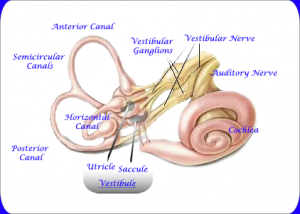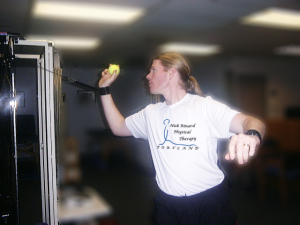By Megan Plante, DPT
21 Mar, 2014
Clinical Case of the Week
BPPV, easily treated, improvement, MDT, Mechanical Diagnosis and Therapies, Mechanical disorder, Nick Rinard physical therapy, Physical Therapy, Portland Oregon, Positive response, vertigo
The most common cause of vertigo (dizziness) is benign paroxysmal positional vertigo (BPPV) and it is a mechanical disorder. A trained clinician can evaluate and treat this condition based off of the patient’s symptoms. The evaluation consists of moving the head into specific positions. Symptoms of BPPV include vertigo with change in head position, nausea with or without vomiting and disequilibrium (poor balance).
Curable

Vestibular System
BPPV is a curable condition affecting the vestibular system (inner ear). Your inner ear is comprised of 3 semicircular canals (SCC) and 2 otolith organs. These structures detect head movements (acceleration). Crystals called otoconia are embedded in the otolith organs. Sometimes, the crystals can become dislodged and misplace into the semicircular canals. The misplaced crystals result in increased sensitivity to head movements.
Hopes for a Positive Response
I was treating a patient for low back pain when she mentioned that she was experiencing severe episodes of dizziness. I informed her about BPPV and mentioned that the treatment was very simple and effective. She agreed to have an evaluation in hopes for a positive response.
My patient tested positive for BPPV utilizing the Hallpike-Dix test for the left semicircular canals. I also performed a few other tests and exercises to rule out other potential causes for symptoms. Once we had our diagnosis of BPPV, the treatment was very simple.
Improvement in just one week
I took my patient through a series of head movements that reposition the crystals back into the otolith organs (the saccule and ultricule). After performing the repositioning maneuver, baseline symptoms were decreased and she returned the next week without having any severe episodes of vertigo.
BPPV – A Common Vertigo that is Easily Treated
BPPV is the most common cause for vertigo. Luckily, it is very easy to diagnose and treat with a trained therapist. If you or someone you know has vertigo as a result from head movements, have a physical therapist evaluation so that you may start feeling better today!
More
By Nick Rinard MPT, Cert MDT
07 Mar, 2014
Clinical Case of the Week, Exercise, Physical Therapy Tips
abolished, cervical, MDT, neck pain, shoulder, sugery, true cause of pain
 Very interesting clinical presentation today! The patient had been treated for neck pain here (Nick Rinard Physical Therapy) in the past with good results. Later, she developed shoulder pain and consulted her MD, who referred her to an orthopedic surgeon. There were “findings” on MRI and she ended up getting arthroscopic surgery. She returned to us for physical therapy to rehabilitate after surgery.
Very interesting clinical presentation today! The patient had been treated for neck pain here (Nick Rinard Physical Therapy) in the past with good results. Later, she developed shoulder pain and consulted her MD, who referred her to an orthopedic surgeon. There were “findings” on MRI and she ended up getting arthroscopic surgery. She returned to us for physical therapy to rehabilitate after surgery.
No Surgery Needed
Interestingly, she reported that her surgeon was surprised that her rotator cuff tendons were in “good condition” and did not require a repair – he had noticed that during the surgery procedure itself, apparently. So, physical therapy should be easy in such cases, right? No big surgical repair to worry about.
However, 6 weeks after the operation, her shoulder pain was not subsiding as it should have. Inflammation normally resolves in that amount of time and she should have been strong enough to resume normal office work duties consisting of keyboard and filing.
Finding the True Cause of the Pain
We had to take a closer look at her neck. It turned out that her neck was referring pain to the shoulder! In one neck treatment, the shoulder pain was abolished! The patient probably had had a recurrence of her old neck problem, it referred pain to her shoulder, and neither she, her MD, nor the orthopedic surgeon considered the true cause of the pain…
This is a frequent occurrence here at Nick Rinard Physical Therapy, where we use the Mechanical Diagnosis and Therapy (MDT) system of evaluation and treatment. Robin McKenzie started this method and it is the best method – and most supported by research – at getting to the true cause of pain.
Save time, money, and maybe avoid surgery!
If you or someone you know is having any problems that could be mechanical, a thorough mechanical assessment should be performed. In as little as one visit the problem might be identified and solved, saving a lot of time, money, and suffering! Plus, the patient might avoid unnecessary surgery!
More
TMJ pain can be a real problem for its victims, limiting their ability to chew and talk, and interrupting sleep. Often, headaches even limit the person’s ability to concentrate! Various treatments have been proposed to alleviate the symptoms of TMJ (Temporomandibular Joint) pain, many of which are very complex and even invasive. Looking at the TMJ as “just another joint” and not predetermining that it has to be complicated has been very freeing for me in using a mechanical approach. Let me explain using a patient example from this week in clinic.
My approach is modeled after the McKenzie Method of Mechanical Diagnosis and Therapy, although very little about TMJ specifically has been written or published about it. (1)
Symptoms and Experience
Now, about the patient. (Name and other identifying information has been omitted to protect privacy). This patient complained of intermittent left jaw pain with wide opening of the mouth. He stated it only occurred then, and otherwise it really was not painful. However, chewing tough foods, he admitted, was sometimes painful. His worst pain occurred with rapid opening of the mouth and could be as intense as 6 on a scale of 1-10.
Therapist’s Evaluation and Findings
Objective findings were limited and painful opening with slight left deviation, limited and painful protrusion, limited and painful right deviation, and no pain or limitation with retraction, or left deviation. Repeated tests performed actively by the patient of protrusion first, then of right deviation resulted in producing the patient’s symptoms, no worse after, but also no change in baseline ROM or pain. Forces were progressed to patient applied over-pressure to right deviation. The patient reported that this produced his pain initially, then decreased pain as he performed more repetitions. Subsequently, he reported wider opening with less pain!
Patient Homework
Home exercises were assigned, which naturally consisted of patient applied over-pressure into repeated right deviation every hour or two as per typical McKenzie protocol. On the second clinic visit two days later, the patient stated he was already 50% improved! This finding confirmed the mechanical diagnosis of derangement syndrome. In this classification, there is a good prognosis for rapid and lasting recovery from the problem.
Get Yourself Evaluated
This is only one clinical example of a purely mechanical TMJ problem. While there are examples of TMJ issues that are not derangements, or even mechanical, often a mechanical cause of the pain can be found and the patient helped by mechanical therapy. It is well worth a thorough examination to determine if your TMJ pain has a mechanical component, and to get appropriate treatment which would otherwise be missed.
(1) http://www.sciencedirect.com/science/article/pii/S1356689X1100230X
More
Medical Advisory: Choose Your Physical Therapist Wisely
by
The purpose of this essay is to inform you that not all Physical Therapy is the same. Some are more effective than others. If you had Physical Therapy, did it work? If you are going to Physical Therapy now, is it helping? If yes, you should continue until you are better. However, if you are not getting better, or if you need Physical Therapy in the future, then you should read on.
First choice for treating spinal pain
Mechanical Diagnosis and Therapy (MDT) has been shown in numerous scientific studies to be the most effective type of Physical Therapy available today. In a poll of Physical Therapists nationwide, MDT was the first choice for treating spinal pain (APTA publication 2002). This is a good thing, since it shows that the profession of Physical Therapy is gaining more and more scientific evidence to support its use. However, you should know just what MDT is so you can be sure you are actually receiving it.
Development of MDT
MDT was developed in New Zealand by a physiotherapist named Robin McKenzie. Mr. McKenzie noticed that his patients got better faster, and could control their pain themselves, compared to patients being treated traditionally. He founded the McKenzie Institute and has been training therapists since 1980. You should choose a therapist that is a certified MDT therapist, designated by Cert MDT.
What – no gadgets?
The MDT method does not rely on technological gadgets such as ultrasound or electrical stimulation commonly used in traditional Physical Therapy. There is little evidence to show that these machines actually help in recovery. Instead, Mechanical Diagnosis and Therapy, as its name suggests, uses mechanical forces to centralize referred pain, and to correct the physical problem. Exercises designed specifically for each patient, affect pain immediately, and can be performed by the patient whenever pain arises. Over a short time, these exercises heal the injury and allow full recovery. In our clinic, Nick Rinard Physical Therapy, the average number of visits is only six and a half!
Your Time is Valuable
A very important part of the MDT method is the evaluation on the first day. A qualified Cert MDT therapist should be able to identify if you will respond or not. This way, if the problem is not mechanical, valuable time in your recovery is not wasted, since you would not go through several weeks of rehabilitation to discover at the end that it did not help. Doctors who have the best interests of their patient in mind prefer MDT for this very reason. If your doctor is not aware of the MDT method, then you can choose an MDT therapist yourself. It is considered standard practice and has been accepted by the medical community.
Medical Advisory: MDT is a Superior Form of Physical Therapy
If you sustained your injuries in a motor vehicle accident, or work-related injury, then your chances of getting better are improved if you choose an MDT therapist. There is a financial advantage also since the total cost of your therapy will be less, based on the fewer number of visits MDT uses. Your PIP money will go further, and you will not have to sacrifice a large amount of money out of your settlement just to pay high physical therapy bills. If you are a worker, your case will be less likely to be denied if you are getting better faster, than if your recovery drags on. Believe me, insurance adjusters are less likely to keep your case open if you are not improving in physical therapy.
MDT compared to Chiropractic
So you can see that MDT is a superior form of physical therapy. What about MDT compared to Chiropractic care? I tell my patients that Chiropractic treatment is indeed mechanical, but there are two distinct reasons it is not superior to MDT. The first reason has to do with the evaluation, and the second reason has to do with the treatment. A chiropractor first must take an X-ray to make the diagnosis. Unfortunately, there is little evidence to suggest a chiropractic diagnosis is reliable, and therefore, treatment based on an unreliable diagnosis is a guess at best. Secondly, chiropractic treatment is performed to the patient, not by the patient. Any improvement in the patient’s condition, therefore, is dependent on them going back for more visits! As mentioned, MDT treatments consist primarily of exercises that the patient performs so you can treat yourself when not in the clinic. This obviously results in less pain, a speedier recovery, less visits, and money saved!
MDT Treatment is more effective and takes less time
By reading this essay, you are now equipped with knowledge to seek out the best care possible for your injuries. Don’t waste time going to traditional physical therapy, or chiropractic for many visits. It is better to get an MDT evaluation to determine if your condition will respond mechanically or not, and if it is mechanical, then the treatment is more effective and takes less time!
Better in only 6.5 visits
In closing, I would like to mention how MDT compared to traditional physical therapy in an objective study conducted by a third party. The average improvement in traditional physical was only 78 percent, and it took an average of 11 visits to achieve this. By contrast, MDT got patients 93 percent better in only 6.5 visits! The data speak for themselves. Don’t settle for less effective treatment for your injury – find a Cert MDT therapist who is using the MDT method properly, and get better faster!
Nick Rinard is president of, and a therapist at, Nick Rinard Physical Therapy, a private physical therapy clinic.
More



 Nick Rinard
Nick Rinard